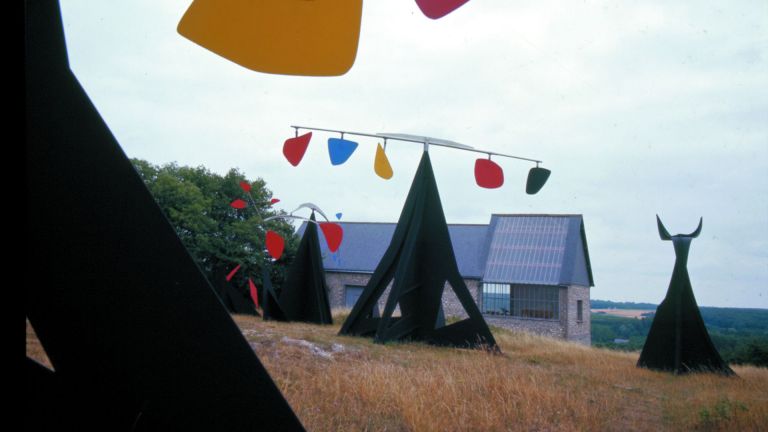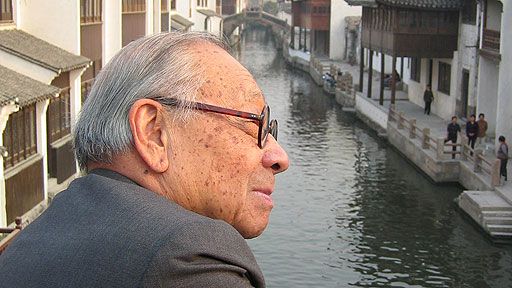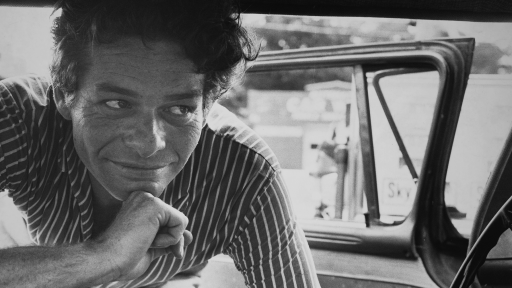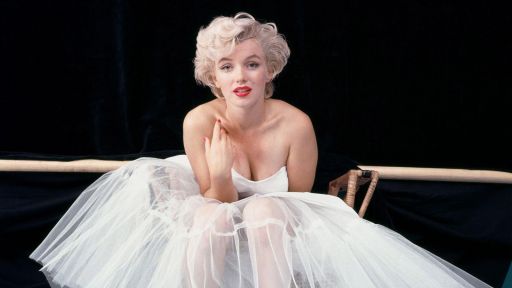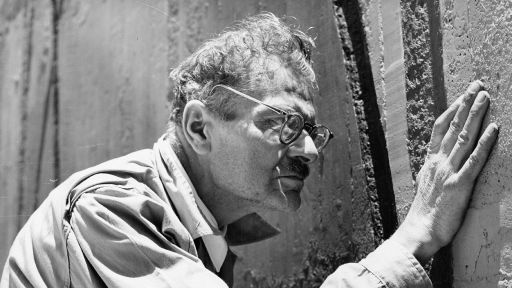TRANSCRIPT
♪ ♪ ♪ ♪ ♪ ♪ ♪ ♪ ♪ ♪ ♪ ♪ ♪ ♪ ♪ ♪ ♪ ♪ ♪ ♪ ♪ ♪ ♪ ♪ Up until Sandy Calder's time, sculpture was an expression of solidity, of motionlessness.
It turns out that something else was possible.
The flight of a bird was possible, or the seeming flight of the bird.
And it says we are ourselves then more than earthbound.
It shatters the illusion of everything that sculpture ever was.
It is unlike any body of work created this century.
He changed the nature of sculpture.
He redefined what sculpture was, could possibly be, and now is.
Narrator: on the day of his birth, July 22, 1898, Alexander Calder already had art in his blood.
His mother was a painter.
His father and his grandfather were both famous American sculptors.
Their scottish forefathers, for generations, had been stone masons.
But nothing in any of their work foretold the daring, the exuberance, the wackiness, the sheer beauty of the things that this boy would grow up to make.
Sandy Calder grew up immersed in art, modeling for his parents, making his own toys.
Woman: this was a household where art was the sort of daily parlance of living.
Calder as a child, had a studio.
I mean, he had his own little workshop.
So there was already this comfort level with tools and with materials and with making things.
And his sister talks about watching him make a dog and a duck when he was a youngster.
And she said he cut out the elements and they were flattened like a pelt, but then he made that conceptual leap from two dimensions to three, and he took these small pieces of metal and with relative ease configured them into two little animals.
Narrator: years later, Calder remembered one of his early experiments.
"I made an electric light plug "out of a cork, a nail, and a piece of copper wire.
"but after drawing an enormous spark from this apparatus, I quit bothering electricity."
Despite his background, he was far from eager for a career in art.
"My father said, 'what do you want to study?'
"and here I was a bit nonplused.
"but a fellow at Lowell High School told me "he was going to be a mechanical engineer.
"I was not very sure what this term meant, but I thought I'd better adopt it."
At the Stevens Institute of Technology in Hoboken, New Jersey, Sandy Calder favorite subjects were sports and girls, but he also managed to learn some serious science that one day would serve him well -- mathematics, physics, kinetics, and the nature of industrial materials.
He did not make much of an engineer.
In his first job he lasted all of two weeks.
He grew an unfortunate moustache and was fired for loafing at a window sash factory.
As an insurance detective, he disliked the office lighting, and quit.
Trying to sell a sort of early rototiller in West Virginia, he mowed down a perfect row of cucumbers.
Working on a freighter off Guatemala, Calder woke up on deck one morning to a life-defining experience.
Forty years later, he recalled the moment.
"I saw the beginning of a fiery red sunrise on one side "and the moon looking like a silver coin on the other.
"of the whole trip this impressed me most of all.
It left me with a lasting sensation of the solar system."
Finally he could no longer resist his calling.
In 1923, now 25 years old, Calder entered the art students league in New York.
He painted, he drew, he tinkered.
With no clock in his meager room on 14th street, Calder fashioned a wire rooster mounted on a rod with radiating lines at the foot to indicate the hours -- a sundial.
He sketched his fellow strap-hangers on the subway.
He loved painting the streetscapes, the harbor, the city parks.
He made his first small fees as an artist drawing scenes of New York for the racy National Police Gazette.
The Gazette sent Calder to the circus, and he was entranced.
For two weeks, day and night, he drew and drew and drew.
In 1926, Calder set sail for the center of the world of art, the world of Pablo Picasso, Ernest Hemingway, Gertrude Stein, Jean Cocteau, Piet Mondrian -- the birthplace of modernism -- Paris.
Gill: it was the place to be in the 1920s.
Virgil Thompson was there.
F. Scott Fitzgerald was there.
Anybody who was engaged in the arts was very likely to turn up in Paris, and to be able to live quite well and have a good time, and to join other people in the same milieu.
They were breaking new ground, or trying to do so.
And certainly Sandy was breaking new ground more than anybody, as it subsequently turned out.
Man: he didn't know exactly what he was going to do.
He was doing illustration.
He made some posters, whatever he could get, basically.
And he was truly for the first time so much on his own, you know, so much under his own steam, that I think it really allowed him to experiment.
Narrator: in a tiny rented room, subsisting on a monthly stipend from his parents, Calder still reveled in his favorite childhood pastime, tinkering with wire and wood.
The results were playful, even toy-like, but this was deeply serious child's play.
Man: wire allows him to sort of draw with metal.
Many of them are made of a simple single strand of wire.
It's like one of those sparklers that you do in the air like this, and you make a drawing in the air.
And it's everything is connected, and then it's gone.
Narrator: on the left bank, the cabaret performer Josephine Baker was drawing crowds of feverish devotees.
One of them was Alexander Calder.
He could create a living likeness with a single piece of wire.
Over the course of four years, he made a series of Josephine Bakers.
Prather: Josephine Baker was a dancer who attracted him, and I think it was the kineticism of her, of her body, of the wonderful gyrating, writhing movements that she made, and for which she was so justifiably famous, and clearly this somehow captured Calder's imagination.
Narrator: he was never without a roll of wire and a pair of pliers in his pocket.
When he went to a party, he would make a wire portrait of every person there, as a gift.
Man: the wire portrait's an amazing invention, an amazing idea.
And these were much more than caricatures.
These were not just, you know, cartoons.
It was a kind of complex portraiture which brought the quality of somebody into the round, into a three-dimensional format for the first time.
Narrator: Calder's work was not only like toys, sometimes it was toys.
On commission for a company in Oshkosh, Wisconsin, he made a rowboat, a kangaroo, a bucking cow, a wire bird struggling to yank a wire worm out of the ground.
Still fascinated by the big top, Calder constructed dozens of animals, acrobats, and mechanical devices, until he had an entire miniature circus.
He would perform the whole thing himself, in his apartment, charging around the room blowing whistles, making animal sounds, operating a dozen contraptions at once, while his friends smoked and drank and laughed themselves silly.
Before long, these uproarious evenings became the hot night out in Paris.
Cocteau and Mondrian came.
Joan Miro, Fernand Leger, Man Ray, Jean Arp, all came to Calder's circus.
He would go on performing it from time to time for decades to come.
[blows whistle] mesdames, messieurs, nous present le cirque.
Art thou ready?
I am ready.
Stevens: I think his circus and the toys and the animals are among his best work.
They are absolutely without pretention, without that kind of sweat that sometimes comes into art when the artist is trying to be big and important and ambitious.
The circus, you know, was a great symbol for many artists.
But many artists also saw in the circus a kind of dark expressionist note.
The circus was a place of masks and of unconscious desires.
Calder actually liked the circus for being a circus.
Man: well, the circus, he was in his element.
See, he was a big kid, big child.
He would huff and puff and run around all over the place, making the things work.
And his great pleasure was when the kids exclaimed with surprise.
That pleased Sandy enormously.
It meant, really, that everybody was believing it.
Narrator: in the fall of 1927, Calder crushed his whole circus into two suitcases and took it to New York.
He could remake a piece in minutes.
One look was enough to persuade the art dealer, Carl Zigrosser, to offer Calder a solo exhibition, his first.
"we priced these things at $10 and $20," Calder later recalled.
"two or three were sold."
In Greenwich Village he rented a bizarre triangular room lined with gold leaf, and took up woodcarving.
He would return to Paris for a while, then back to New York, crossing the Atlantic regularly.
Not only was Calder's creativity blooming, so was his eccentricity.
Years later, he reminisced about the '20s in Paris.
"I had an orange bicycle "with which I used to run around the Quatorzieme Arrondissement.
"I wore gray knickerbockers and red socks.
"at one point I had a cold "and held a piece of camphor under my nose with a wire that looped and went around my ears."
As a child, nobody ever said, "no, no, you can't do that."
He did anything he wanted to do, and he did it from the very earliest childhood on.
And he never changed.
He was always a child -- and a very happy child.
Narrator: a one-man show in Paris was rather harder to get than in New York.
Finally a dealer named Vorms, whom Calder would forever call Monsieur Worms, offered his gallery, as long as the artist would pay for the privilege.
The show was a modest success -- enough, at least, for Calder to earn back the bribe.
After his second European exhibition, in Berlin, art critics began as last to take Calder's work seriously.
"the figures are amazing," wrote one reviewer.
"in these works of art all artistic rules are suspended."
Aboard ship once more in 1929, Calder met Louisa James, grandniece of the philosopher William James and the novelist Henry James.
They fell deeply in love.
At his second New York show, hardly a year since the first, the gallery was practically overflowing with wire sculptures, woodcarvings, paintings, toys, and jewelry.
What would prove most significant, he had begun to create freestanding mechanical sculpture.
As his reputation grew, the newly founded Harvard Society of Contemporary Art invited him to show his wire sculpture.
Ross: they were very excited that they were going to do a show with Calder.
And they pick him up at the train, and he doesn't have any art with him, and they're flabbergasted.
They'd scraped together money to bring him up to Cambridge to have this show.
And they said, "Sandy, what's going on?
Where's the art?"
And he reaches into the pocket of his overcoat.
He pulls out a roll, a spool of wire, and he says, "here it is."
And he goes off to the gallery with them, and he creates the show on the spot.
Narrator: in the fall of 1930, back in Paris again, Calder visited the studio of Piet Mondrian.
"it was a very exciting room," Calder later recalled.
"the wall was covered with colored cardboard rectangles.
"I suggested to Mondrian that perhaps it would be fun "to make those rectangles oscillate.
"and he, with a very serious countenance said, "'no, it is not necessary.
"my painting is already very fast.'
This one visit gave me a shock that started things."
Prather: the visit to Mondrian's studio in a way was a kind of dramatic catalyst.
The idea of movement was in Calder's mind.
It was this kind of marriage of abstraction and movement that somehow Mondrian seemed to provide the stimulus for.
After the visit to Mondrian, he goes back to the studio and has some ideas and begins to work them out on canvas.
But then very soon after that, I think, he probably became frustrated with the painting, and he felt somehow a need to get back to sculpture.
And so within two weeks that's exactly what he did, and he started making abstract sculpture for the first time.
Narrator: this was a time of great discovery -- the previously unknown planet Pluto, Einstein's theory of relativity, a whole new paradigm of the cosmos.
Typically, Calder both made use of the new cosmology and made light of it saying, "the underlying sense of form in my work "has been the system of the universe, a rather large model to work from."
Einstein himself came to a Calder show, and he stood transfixed for 40 minutes through an entire movement cycle of a piece Calleda Universe.
Prather: Calder's first abstract sculptures, kinetic sculptures, were motorized sculptures.
And I think he found them distracting.
There is a great deal of repetition.
They broke down, one had to repair them.
He said at one point, "better a good sculpture than a good motor."
And one has to remember that the whole idea of chance was very much in the air in Paris.
And he eventually came to desire chance and chance movements in the sculptures.
Narrator: with the joining of pure abstraction and random motion, Calder art took flight.
"what shall I call these things?"
Calder asked his friend Marcel Duchamp.
Duchamp replied, "Mobile," a french pun meaning both "motion" and "motive."
Until Alexander Calder invented it, the mobile had never existed.
To Jean-Paul Sartre, the mobile embodied an absolute purity of abstraction.
"a mobile is a little private celebration," he wrote, "an object defined by its movement, "and having no other existence.
"a mobile does not suggest anything.
"it captures genuine living movements and shapes them.
"mobiles have no meaning.
"they make you think of nothing but themselves.
They are -- that is all."
Miller: he was trying to do something that was quite unusual and maybe even unique, although Miro, as he often said, was his direct inspiration for a lot of these shapes.
But the idea of a living, moving piece of sculpture made of wire and sheet metal -- it was not an old idea.
He absorbed information very quickly, in a way that artists do, because artists can be in a room, they can see things, they can pick it up, and it can come into their work right away without even thinking.
So that you can look at what he does, and maybe, you know, Miro will come to mind at a certain point, or Paul Kleve, or even Picasso, but it's not an issue, and you don't really think about them.
It always somehow really remains sort of immediately and totally Calder.
Narrator: Alexander Calder and Louisa James were married in 1931.
They decided to put down American roots in Roxbury, Connecticut, in a dilapidated 18th-century farmhouse that Calder painted black.
He bought an immense old Lasalle convertible, which he would drive for the next 17 years.
Sandy and Louisa had two daughters, and the four of them traveled often to France.
Rower: in 1937, he makes his first outdoor stabile, called The Whale.
He has this vision of making large work for public spaces.
And he made a whole series of little maquettes, little models, which were intended to be enlarged, hoping that someone would come along and say, "great, I want one for my garden."
And no one did.
Narrator: but that same year, he got his first important public commission.
For the Spanish pavilion at the Paris World's Fair, Calder created a fountain in which not water but mercury flowed.
Mercury fountain was also his first overtly political work, a tribute to the anti-fascist partisans of the Spanish Civil War.
By the late 1930s, Calder was renowned throughout the art world.
And in 1943, at the age of 45, he became the first member of his generation to be honored with a life retrospective exhibition at the Museum of Modern Art in New York.
Yet Calder himself resolutely refused even to call his work art.
He called his pieces "objects."
"that way," he said, "a guy can't come along and say, 'no, these aren't sculptures.'
It washes my hands of having to defend them."
Miller: he was very unwilling to talk about art.
I never heard him refer to a critic or anybody's opinion about himself.
I never heard him praise stuff, either.
He was absolutely uninterested in talking about the whole damn thing.
Either you did it or you didn't do it.
You knew how to do it or you didn't know how to do it.
Woman: he never talked about art with me.
For instance, I used to draw all the time.
And I remember one day I showed something that I had just finished to my father, and he said, "well, what's that?"
And my mother got indignant and she said, "one could ask that of you, too."
Narrator: with Calder's favorite raw material, aluminum, reserved for the war effort, he took to carving wood and incorporating shards of glass in his objects.
[ding] [ding] by then, music, too, entered his work.
[ding] [ding] [ding] [ding] Calder would work in any medium -- plaster and bronze, he created rugs, aubisson tapestries and commercial wallpaper.
He designed stage sets, and collaborated with the choreographer Martha Graham.
He illustrated books.
He made posters and prints.
Calder began every day painting in gouache.
He particularly loved to make jewelry for Louisa and their friends.
Prather: these were hands that were never at rest.
And when he wasn't making sculpture in the studio, he was making jewelry, he was making toys for his two daughters.
And there was a need in him, I think, to constantly keep those hands working.
And they were hands that by the end of his life could virtually do anything with the medium he chose.
Woman: when I walked into Calder studio, I was amazed at how many objects were there and how messy it was, how it was very much a work in progress.
There were wires and tapes everywhere, parts of wooden sculptures, and one always had the idea looking at all of this that the artist was constantly working, constantly inventing new forms, and going back in some cases to earlier works that he had created.
Woman: you know, his studio was huge and chaotic, not for him, but for everybody else looking at it.
I mean, that desk, you would not believe.
But he would just go in there, and sometimes we would think of some friends in Paris.
He said, "look, let's write her a postcard."
And I said, "I don't have the address."
He said, "I have the address."
And he'd go in and pick out, with his big fingers, he'd pick out a tiny piece of paper, voila!
Man: I first was lucky enough to be assigned to do the Calder kitchen throughhouse and garden.
And it was like walking out of the dark into the bright sunshine to see the atmosphere that they had created.
It was full of Legers and Miros on the wall, and then all the marvelous ladles and stuff that Sandy had concocted by flattening out tin cans.
He had made the cupboards.
There wasn't anything in there that had been bought within the last 30 years.
It was just enrapturous.
Narrator: now in his late 40s, Calder began to realize his dream of making ever larger works.
Punning on Duchamp's pun "mobile," Jean Arp had dubbed Calder's nonmoving sculptures "stabiles."
Nothing like these immense abstract monuments of bolted steel had ever been seen before.
Stevens: they're monumental forms that are not overweening or aggressive.
They don't have the usual macho of public sculpture.
And they also have an implied movement about them for some reason.
Gill: the stabiles are often animal forms that we have, I think, in our unconscious, and we look sometimes at a Calder waiting there for us, and at first we have to decide, is it friend or foe?
It turns out, because of the nature of Calder himself, who was a sweet, dear bear of a man, that it was friend and not foe.
But there was something in there, something primordial, something that perhaps our DNA, three-million-year-old DNA was responding to in those shapes.
Narrator: near the French village of Sache, Calder bought an old farmhouse and set up his biggest studio yet.
Here his sculpture could grow even more monumental.
For an auditorium in Caracas, he designed a huge system of panels 30 feet long, floating below the ceiling.
Their effect on the acoustics was remarkable.
An interviewer asked Calder why he was making sculpture of such unprecedented scale.
"it's more exhilarating," he replied, "and then one can think he's a big shot."
Calder was changing the very idea of public sculpture.
Where a 19th-century artist would have put a war hero on a horse, Calder put a lyrical abstraction.
In place of bombast and grandeur, his art evoked contemplation -- in place of solemnity, a smile.
Gill: Calder was absolutely indispensable to the kind of buildings that were being built in the postwar period, because they were so severe.
And they were, at their very worst, let's say, slab-like.
And they were in desperate want of some humane touch.
It was a quality of the penitentiary at best.
He was able to rescue the buildings.
I don't know whether he himself was conscious of the degree to which he was being used as a one-man rescue operation, but that's what it frequently was.
Ross: the idea of site-specificity, you know, Calder invented that.
The artist goes to a place, tries to understand the nature of the physical place, and the social nature of the space, and then create work in reference to all of those elements, to understand that modern art really is a complex response and not just simple, visual facts, but a more complex and deeper understanding of modern life.
Man: when I had my opportunity to commission him at M.I.T., I did so, and he made the Great Sail, you know, right on the axis from the Charles River all the way into -- to a building that I designed.
I think it was close to wintertime.
He was there making it.
And he loved to show it to the students.
Students would come by and ask him, "what are you doing?"
And he was very happy explaining to them.
And that was for me really the reason why that piece was so well-liked.
He's very child-like.
He somehow seemed to me like a grownup child.
I made the remark, and I don't think it's unfair to say that in a sense what Einstein gave to science in the dimension of time, you've given to art in the dimension of motion.
I don't know about that, but what would Einstein say?
Well, that's a very interesting point.
Well, now, how do you know when you're finished?
Uh, when it's dinnertime.
Miller: the first time I laid eyes on Sandy, actually, it must have been in '51, probably around there, and I was in a gas station in Woodbury getting some gas, and this gigantic Lasalle touring car drove up, and it had no top.
It was dead of winter, and this gigantic fellow was sitting behind the wheel with this sheepskin coat on.
It was actually the skin of a sheep.
And he had a remarkable voice.
Nobody could understand him except people who wanted to understand him.
And he was... [mumbling and growling] Klaus Perls: he was not the artist with the chip on his shoulder.
Dolly Perls: I've never known anyone like him.
No, because he didn't have the problems most people have.
He didn't accept the problems.
He didn't -- he didn't own a suit.
He had two shirts, two wool red shirts, and that's what he wore -- to dinner parties, to formal openings, it didn't matter.
Narrator: just as his art did, Calder life celebrated laughter, play, and fun.
Davidson: he was a terrible tease.
I remember for Christmas once he gave everyone plumber's helpers, you know, those rubber plungers, and they each had a bow around them and they stood out under the tree.
And he had painted everyone's name on them as a gift.
Rower: when the Calders came back from Brazil in 1948, they brought with them all these great samba records, and they threw samba parties.
That had samba lines, you know, in Roxbury.
Just crazy, really crazy times, and wonderful times.
I danced with Sandy.
He was one hell of a dancer.
He was a very good dancer, but a very rough dancer.
You were apt to be thrown on the floor if you weren't careful.
Man: well, he was a large man to begin with.
Of course he ate too much and drank too much wine, so he was a big fat fellow.
But the great thing about him was, if he was a friend, he was so generous you could hardly believe it.
Man: I remember I met Calder, and I was a little smart-alecky, I guess, and he said, "you may be good now, but can you last 10 years?"
He sort of put me down a little bit.
And I thought, oh, boy, you know, that's that.
Shortly after that I came back to New York, and he came down to see me.
And when he left I noticed on the table he had left a $50 check for my rent, and I was shocked.
Rower: I've now discovered really how generous he was, just how many, literally thousands of works he gave away to his friends, his associates, the guy down the road who cut the field in Connecticut, that kind of thing.
Everybody got something.
It's really sort of overwhelming.
Narrator: the 1950s and 1960s brought accolade upon accolade for Calder.
He won the sculpture prize at the Venice Biennale.
Now his work was in nearly every major museum in the world, but he never slowed down.
Rower: he worked every day.
In the process of making the Catalogue Raisonnee, we've identified 16,000 works, which includes all works of all media, from the smallest little sketch to monumental sculpture.
But that means he was making a work a day for 50 years.
Narrator: the scale of his work continued to grow.
In 1958, Frank Lloyd Wright asked Calder to design a giant mobile for his new Guggenheim Museum in New York, the biggest Calder mobile ever.
Wright demanded the piece be gold.
"fine," said Calder, "it will be gold, but I'll paint it black."
He did not get the commission.
For the Italian hill town of Spoleto and its festival of the arts in 1962, he made his biggest stabile yet, Teodelapio, 60 feet high.
For the expo '67 World's Fair in Montreal, he made a stabile titled Man that was seven stories high.
In a way, Alexander Calder had taken on the role of his father and grandfather -- acclaimed author of big, grand, crowd-pleasing public statuary -- but these were a very different kind of statue.
In the art world, Calder's work was now comfortably familiar, but for many of the general public, abstraction was still a mystery, to some even a threat.
In Grand Rapids, Michigan, in 1969, the proposal for a huge Calder in front of city hall met with both outraged protest and passionate support.
Woman: wow, this is great for me to be here.
And I'll tell you why.
Because 25 years ago, this was the first public project that the endowment supported.
$45,000 they gave to Grand Rapids and Kent County for this gorgeous sculpture.
Twenty-five years ago, it was very difficult to get this sculpture installed.
There was a lot of opposition to the idea of federal funding for a public piece of sculpture.
There was a lot of opposition to the money, to the abstract object, the fact that it was going to be red.
People said if it was red it was going to be part of a communist plot.
And I had a lot of hate mail.
And then there were the obscene phone calls.
But I think the most exciting experience was having my front window shot out with a rifle the day of the dedication.
And when the county sheriff came and he looked at it he said, "oh, lady, somebody really doesn't like that big red thing."
Man: you have to remember how few sculptures of this kind were in any American cities.
To put a modern sculpture of such grand magnitude, such bright color, in the very heart of the city, at city hall, was something that was extraordinary and took a tremendous leap of faith on the part of the people.
That, that great work of public sculpture transformed the consciousness of a city.
I mean, the Calder emblem is printed on the sides of the garbage trucks of that city.
It's become the image of a city.
Narrator: Calder's playfulness never flagged.
He painted two DC-8 jets for Braniff Airlines.
He painted a race car for BMW.
He detested the Vietnam War, making posters and donating original art for the antiwar movement.
He was political in that he had very definite ideas, but it was my mother who was much more of an activist really.
They marched in Washington.
They were some of the original people for the petition against the Vietnam War, and they became part of Nixon's enemy list.
Stevens: the 20th century is such a tormented and difficult century that there has not been much art that takes seriously the idea of joy and pleasure and childlike qualities.
Calder creates a world in which there is no evil.
And that's a very appealing idea, and a profound idea in its way.
Very few people of intelligence have been able to sustain or buy into that kind of world view.
Calder is one of the very few who does so without seeming corny or sentimental.
Glimcher: Calder's work isn't childlike in the sense that people think it is.
Calder is innocent.
Every great artist is a great artist because he perceives the world as though it's being seen for the first time.
That is the innocence of Calder.
But Calder's work is very masculine, is very serious, is the work of an engineer, is the work of a mathematician, but also strikes this chord of pure innocence.
Narrator: in rome, Calder realized a lifelong dream, a ballet in which every dancer, indeed the dance itself, was a Calder sculpture in motion.
Work in Progress, as Calder titled it, took all of 19 minutes, but its subject was no less than the creation of the world, from the beginnings of life on earth to the arrival of man, civilization, and war.
It was silly and scientific, philosophical and frivolous, crazy and profound.
"maybe I should have called it My Life in 19 minutes," he said.
On October 20, 1976, the Whitney Museum opened an exhibition of Calder's life work in all its astonishing variety and unity.
The artist whose model was the cosmos had, himself, created a world.
Three weeks after the opening, on November 11th, at the age of 78, Alexander Calder was dead.
Miller: you know, every time I pass that house, which I do a couple of times a week, I lament how short life is, because he could have gone on forever and ever, turning out these delightful pieces of work.
I do think, though, that the best of his work has captured something in the -- maybe just the mechanics of the universe, and the tension between stillness and motion.
It is most pleasing, it is most engaging, its fascination is never-ending, and you just feel better for having stared at it for a while.
♪ ♪ ♪ ♪ ♪ ♪ ♪ ♪ ♪ ♪
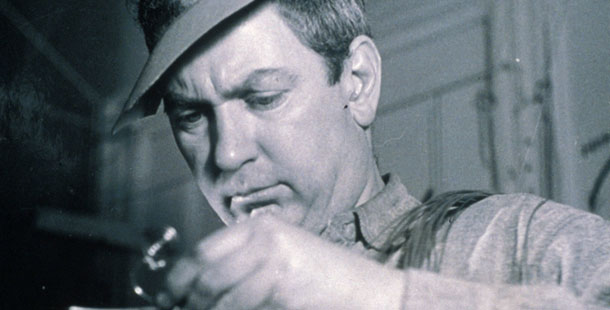 It was then that he began work on one of his most famous projects, the “Calder Circus.” The “Circus” was a miniature reproduction of an actual circus. Made from wire, cork, wood, cloth and other easily found materials, the “Circus” was a working display that Calder would show regularly. A mix between a diorama, a child’s toy, and a fair game, Calder’s “Circus” found many eager fans among the avant-garde. One of the methods used to create the “Circus” was the bending of wire to form realistic figures. Drawn to the ease and simplicity of it, Calder began to make wire portraits. A combination of a line drawing and of sculpture, these instant portraits represented a new possibility in three dimensional art.
It was then that he began work on one of his most famous projects, the “Calder Circus.” The “Circus” was a miniature reproduction of an actual circus. Made from wire, cork, wood, cloth and other easily found materials, the “Circus” was a working display that Calder would show regularly. A mix between a diorama, a child’s toy, and a fair game, Calder’s “Circus” found many eager fans among the avant-garde. One of the methods used to create the “Circus” was the bending of wire to form realistic figures. Drawn to the ease and simplicity of it, Calder began to make wire portraits. A combination of a line drawing and of sculpture, these instant portraits represented a new possibility in three dimensional art.
